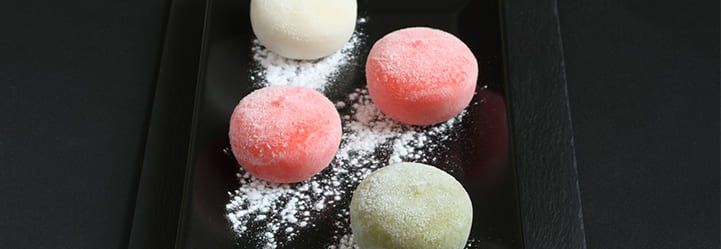Types of mochi and how this dessert has risen in popularity
Alimentos SAS • Dec 29, 2021
Consumers have been finding the Japanese dessert mochi at retail locations for years now. It is a unique option that caters to adventurous palates looking for something different to indulge their sweet tooth. Let’s take a look at its characteristics and the types of mochi available today.
What is mochi?
Mochi is a Japanese chewy snack made from mochigome –short-grain glutinous rice (Dayman, 2018).
How is it made? First, the mochigome is soaked in water overnight and then steamed. Afterward, it is mashed and pounded until it becomes soft and sticky. The traditional method needs at least two people operating a mortar and a heavy mallet. Nowadays, industrial producers use machines to make it (Baker, 2021).
The history of mochi
Archaeologists have discovered tools used to make mochi dating back to the Japanese Kofun Period (250 to 538 AD) (Dayman, 2018). Culturally, mochi is tied to rice’s significance in Japan. It is also tightly related to Shinto practices of thanking the gods for providing the harvest (Baker, 2021).
Today, mochi is a popular snack all year round. Nevertheless, people associate it with seasonal events in Japan, such as New Year celebrations. Some specific periods, like the cherry blossom months of spring, have their types of mochi (Dayman, 2018). Sakura mochi is an extra-sweet, pink version that contains red bean paste. It comes wrapped in a salty cherry blossom leaf for flavor contrast (Baker, 2021).
What are the different types of mochi?
Nowadays, mochi seems to be thriving. Experts say its global market outlook for the next seven years remains robust. Wider product portfolios, innovation trends, and expansion into niche segments will drive the segment’s behavior (TGM Markets, 2021).
Moreover, the increasing number of mochi brands at retailers hints toward its popularity among consumers. So, what are the main types?
Savory mochi
Although people know it more as a dessert, mochi can be savory as well. Some examples include (Baker, 2021):
- Isobe maki or isobe yaki, which, if you don’t know, is grilled mochi wrapped in nori seaweed and dipped in soy sauce.
- Ozoni soup, made with vegetables, meat, or fish with pieces of mochi.
Sweet mochi
Some popular options include daifuku, which has a sweet red bean paste filling, or ichigo, which has a strawberry filling instead (Baker, 2021). However, international consumers are more familiar with mochi, as it is one of the many types of ice cream available today (My/Mochi Ice Cream, n.d.).
Overall, experts say the global ice cream market will reach an 83.1 billion dollar value by 2025 (IMARC Group, 2021). Much of this performance has to do with answering consumers’ interests, such as premium real ice cream, health-oriented functional products, or alternatives catering to specific lifestyle choices, like plant based ice cream.
Americans consume about 23 pounds of ice cream and related frozen products each year (Dairy Foods Association, n.d.). As mochi ice cream falls into that segment, let’s take a deeper look at it.
Ice cream is the king among the different types of mochi
Essentially, mochi ice cream is mochi dough with a sorbet-style ice cream filling. Japanese-American businesswoman Frances Hashimoto created it in California in the 1980s. It grew popular during the next decade as a special trait available at Asian fusion restaurants in the U.S. In time, it found its way to retailers and wider audiences (Malavenda, n.d.).
Among the existing types of mochi, the ice cream variation takes advantage of consumers’ inclinations toward desserts full of natural flavor. Fruit-flavored ice cream’s global market share is growing (Fortune Business Insights, 2021). The FONA Flavor Radar reports the world’s most popular ice cream flavors in the fruit realm are strawberry, cherry, blueberry, and lychee (FONA International, 2021).
This trend covers the entire category, so fruits are prevalent as ice cream, frozen desserts, and even sherbet flavors. Some beloved mochi ice cream flavors include fruity ones like mango and strawberry (Malavenda, n.d.).
With the spotlight on fruit-flavored products, industry players can use purees as ingredients to produce different types of mochi. Why? Because they retain flavor and nutrients from fresh fruit while being logistically convenient (Dohler, n.d.). Furthermore, they serve as natural sweeteners and enhancers (Allied Market Research, 2021. Grand View Research, 2020).
Consumers are the primary driving force in the food industry. Today, they are looking for innovative goods that fit in their on-the-go routines. They also have an interest in social media-worthy products (Hosch, 2018). The different
types of mochi available, especially mochi ice cream, represent an interesting avenue for companies to explore.
















